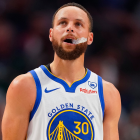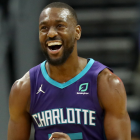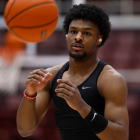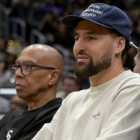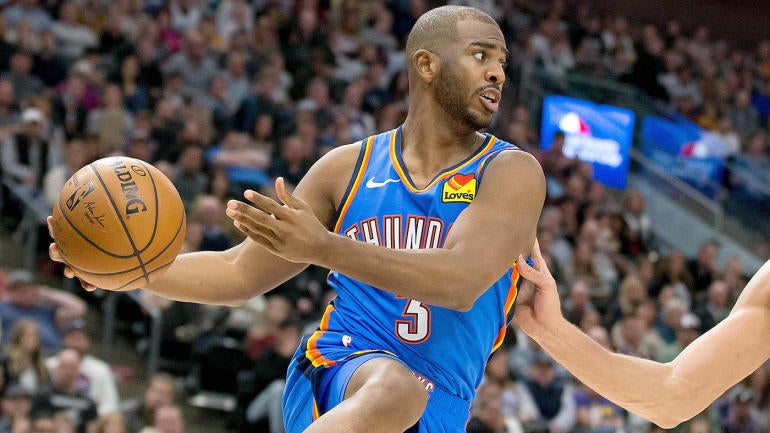
The Philadelphia 76ers are the proverbial "one piece away" championship contender. But it can't just be any piece. It's not a talent shortage Philly is facing, but rather, the absence of a particularly skilled player that can finally tie all those talented pieces together.
Chris Paul is that player.
Before we get into why Paul would be such a perfect fit in Philly, we have to consider whether the Sixers could even get him in the first place. The Thunder are currently a playoff team, and there are whispers around the league they may actually be buyers rather than sellers at the deadline.
Indeed, the Thunder have all the future assets they need. In their own way, they are also one player away -- not from being a title contender, but from being a really good team perhaps in the Denver Nuggets or Utah Jazz tier. Hanging on to Paul and gunning for the playoffs would make some measure of sense.
Still, Paul is not, in a perfect world, a long-term pillar in OKC, which is ultimately looking more down the road as Shai Gilgeous-Alexander hopefully rounds into a franchise player and that trove of assets starts to pay off. Paul is on the backstretch of his road. He'll be 35 in May. At the conclusion of this season, he'll still be owed $85 million over the next two years, including $44.2 million in 2021-22 when he'll be nearing 37 years old.
If the Thunder can move Paul for some semblance of profit, or even just a palatable package to get off his contract, they would presumably be pretty open to discussion in spite of their early season success. Philly can offer an intriguing deal.
It starts with a future first-round pick, which is something a lot of teams wouldn't think of giving up for Paul, particularly given his contract, at this stage of his career. But Philly is in a position where maximizing this current title window should be the priority. The Sixers don't have their 2020 first-round pick, but they could offer their 2021 pick.
In addition, Philly could offer Al Horford and, say, Mike Scott. Or perhaps a package revolving around Josh Richardson if OKC isn't interested in Horford's own long-term, big-money contract -- even with the big incentive of the first-round pick attachment and the connection Billy Donovan has to Horford from his days coaching him at Florida.
Either way, the Sixers should at least be making that call to OKC and offering everything and everyone not named Joel Embiid, Ben Simmons or Tobias Harris. Maybe you have to add in a Matisse Thybulle. That would sting, but they can win a title without Thybulle. They can't win without addressing their point guard situation. It might cost them on the back end of Paul's contract, but title windows close quickly and the Sixers can open theirs wide open right now.
Just think about what Paul would do for the Sixers, who, as currently constructed, continue to force Simmons into a position he just doesn't fit. Paul is a plug-and-play point guard. Just about every offensive issue Philly has would largely go away, or at least become sufficiently mitigated, with Paul on the court. Spacing. Inside-out dynamic with Embiid. Pick-and-roll scoring.
Simmons junks all this up, and the Sixers find themselves asking him to do either too much or too little. He can't be the head of a half-court attack, but sending him off into no-man's land is both a waste of his talent and largely ineffective given his inability to drag defenders with him. The answer might well lie in the middle. Not the leading man, but certainly not an extra. Something of a superstar role player.
Think about Draymond Green with Golden State. He's a far more capable shooter than Simmons -- as is pretty much every player in the NBA -- but given the shooting talent that has surrounded Green the past few years, defenses pay about as much attention to him as a shooter as they do Simmons. If the Warriors stuck Green along the baseline or had him initiating pick-and-roll, nobody would guard him, either.
Instead, the Warriors use the space given to Green as a weapon. With no defender near him, he can rush into impromptu screens without a help defender attached to him. Now the on-ball defender is on his own, and has to navigate a pick with an elite shooter coming off and an elite playmaker as the roller. Green, in addition to his defensive prowess, has turned himself into a Hall of Famer by dominating as a rebound-and-go transition force and a short-roll attacker in the wide-open space created by his point guard.
In this capacity, when Draymond makes an outside shot it's a bonus. When he doesn't, it's not the end of the world. Relieved of that pressure -- both from a media standpoint and as the fulcrum on which so many Philadelphia possessions swing, directly or otherwise -- imagine the damage Simmons could do as a supporting short roller who can do what he's comfortable doing as a downhill playmaker in space. Like this:
Sixers finally going back to using Simmons as a screener. A good way to make him a threat. Notice Scott (shooter) is in the weakside corner and Embiid is at the dunker. He catches on the roll, Capela steps up to help which opens up Embiid. pic.twitter.com/mUj7omC5BY
— Steve Jones Jr. (@stevejones20) January 4, 2020
From that position on the court, a player with Simmons' playmaking abilities cannot be left alone with impunity. From this position, he will punish defenses for any lack of attention, rather than validating their wandering ways as a non-shooter. As evidenced by the clip above, the Sixers do use Simmons as a screener. But not enough. Per Synergy, he's only attempted 13 shots as a roller this season.
You can blame Brett Brown for not instituting more of these actions, or you can blame Simmons for not taking more of an initiative as a freelancing, opportunist picker. But the bottom line is Philly doesn't have a reliable pick-and-roll initiator, or really a half-court-offense initiator in general. They've tried Richardson as a plan B. Both he and Tobias Harris are beyond their depth as lead dogs. By default, Simmons is often the best option on top of the offense.
Contrary to common sentiment, Simmons is effective out of pick-and-roll, when given the opportunity, even without being able to shoot. He's an elite drive-and-kicker. Per Synergy, he ranks in the 87th percentile in pick-and-roll production when you include passes, and in the 96th percentile when you only include passes. But the Sixers clearly don't believe in this action with Simmons at the head. Per NBA.com, they run pick-and-roll just 11.7 times per game, which is the lowest mark in the league.
It doesn't take an analytics expert to understand the problem with Simmons as a pick-and-roll initiator. Sure, he passes great, but generally speaking the most impactful passers are those that first draw attention to themselves as a scorer. Simmons is absolutely no threat to come off a pick and make you pay with any kind of jumper. There is no dilemma as to whether to go over or under the screen. For all his passing prowess, Simmons ranks in the 23rd percentile as a pick-and-roll scorer.
Paul, meanwhile, registers in the 93rd percentile as a pick-and-roll scorer, per Synergy. In late-game situations, you have to have someone who can create offense out of simple actions. That's where the Sixers are missing Jimmy Butler this season, when the running stops and the grind-it-out possessions begin. Entering play on Monday, the Sixers are 22nd in the league in fourth-quarter offense.
Paul, on the other hand, owns fourth quarters -- in which he's shooting 53 percent from the field and 39 percent from 3 while leading the league in total clutch points. In other words, he's money in money time. And he gets it done in the areas from which Philly already operates.
The Sixers, for instance, have a tough time getting all the way to the rim -- where they take just 33.5 percent of their shots, which is the eighth fewest in the league per Cleaning the Glass -- because Embiid and Simmons are often hanging out in that area, which packs defenders in and crowds the space for penetrators. Throw in Horford and the Sixers' paint can start to look like a can of sardines.
They are also a relatively gun-shy 3-point team. Per Cleaning the Glass, only 31.6 percent of Philly's shots come from deep, which is the sixth fewest in the league. Where the Sixers tend to live is in the middle -- top six in the league in both short mid-range and mid-range frequency. These are the spots Paul has owned his entire career, and continues to own even in his 15th season.
Entering Monday, 59 percent of Paul's shots are coming from the mid-range, which ranks in the 100th percentile of all guards, per Cleaning the Glass. Paul is making 51 percent of those mid-range shots, which ranks in the 98th percentile. Free of Houston's 3s-and-layups-only mantra, Paul is back to his maestro ways of snaking in and out of screen fields like he's maneuvering through the cones in a driving test.
Vintage Point God shot.
— Bleacher Report (@BleacherReport) January 1, 2020
Chris Paul getting it done in the clutch. pic.twitter.com/W16eviCtl7
That is the exact kind of open looks the Sixers have trouble creating in crunch time, and Paul made it happen in his sleep. Sixers fans are plenty familiar with these mid-range shots, only they're used to seeing them from Harris and Richardson with defenders blanketed on them. Per NBA.com, 37.6 percent of Philly's two-point field goals are contested by a defender within four feet, which is tied for the third-highest rate of such shots in the league.
Any way you look at it, Paul represents everything the Sixers need. And they, in turn, represent everything he needs. Paul doesn't need to be playing on a rebuilding team. He needs to be playing for championships. He's still at that level. He belongs at the top of an elite offense, and the trickle-down effect of that positional stability in Philly would push everyone else where they belong on the court.
Richardson (if he weren't in the trade) and Harris settle in as secondary playmakers, Embiid gets his ideal two-man partner, and Simmons becomes Draymond Green -- an all-world defender who rebounds and pushes in transition but then cedes to a more capable, and threatening, half-court playmaker when the early offense stalls.
From there, Simmons becomes a screener terrorizing defenses as a short-roll passer and finisher. He can play from the high-post Nikola-Jokic-like hub, only super athletic, comparable to the way Miami uses Bam Adebayo, who is everyone's favorite emerging star despite the fact that he represents exactly zero threat as a 3-point shooter.
Indeed, Simmons' inability, or unwillingness, to shoot doesn't need to be a debilitating handicap. It's never going to be a good thing, but it's made worse by putting him in situations where shooting is a focal point of the positional responsibility.
If you're the Sixers, flip the script. Play to your stars' strengths rather than trying to hide their weaknesses. Call the Thunder. See what they say. Donovan might like the idea of Horford stabilizing a rebuild. The Thunder might think they can flip Horford again next deadline for yet another draft pick or young player, which they might well be able to. Maybe they get a third team involved who's in more immediate need of Horford's services. Maybe Richardson has to go.
Nothing about this prospective deal would come cheap, but neither do championships. Philly is one piece away, and Paul is that piece. He wouldn't guarantee the Sixers a title, but he would put them right on par with the Lakers, Clippers and Bucks. And in a way, finding a more sustainable, suitable role for Simmons pays off in ways bigger than even a current championship run. Solving the Simmons riddle would create an organizational clarity from which all future roster moves can be made.
Simmons is not a point guard. And right now, the Sixers aren't top-tier title contenders. But they could be. And the move to make it all happen might be one phone call away.










